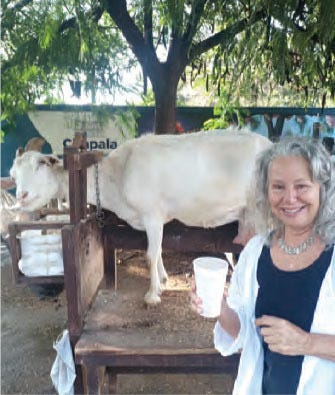Mexico’s Goat Milk Hangover Drink
A morning tradition in rural Mexico combines fresh milk, sugarcane alcohol, and a touch of local wisdom.
As an early-riser, it made sense that when I moved to rural Ajijic (”Ah-hee-heek”), Mexico, I’d encounter pajarete, a traditional hangover remedy made with just-squeezed goat or cow milk… and high-strength sugarcane alcohol.
Roughly translated, pajarete means “early bird,” and that’s what you have to be to find it.
Farmers set up rudimentary milking stands next to their fields, or bring a pick-up truck full of goats to a busy spot and set up shop, usually around 7:30 a.m. Once you know what you’re looking for, they’re easy to spot; this early in the morning, there’s not much else going on.
Customers choose from a potpourri of flavorings to spoon into their empty cup—instant coffee, sweetened powdered chocolate, sugar, cinnamon, vanilla, crumbled peanut marzipan—and then add pajarete’s infamous high-proof cane alcohol, as much or as little as you like.
Next, you take your cup to a waiting goat. The warm, almost-hot milk is squeezed straight from the doe’s fat, swollen pink udder into your cup. The resulting beverage is warm and sweet, topped with a frothy head. Depending on how much alcohol you’ve added, it can definitely pack a punch.
Are there medicinal benefits?
After a raucous Saturday night of drinking, pajarete is the local “hair-of-the-dog.” But since alcohol is optional, whole families partake. Some, like me, carefully add just a teaspoon, and I still felt a buzz…
The raw, unpasteurized, unadulterated milk is the essence of the drink, and locals say it gives them an energy boost. The alcohol is also said to kill any bacteria in the milk. (I imagine it would also kill many other things in your system.) Studies show the proteins in goat milk have anti-inflammatory effects, which can combat conditions like asthma, allergies, and arthritis. It’s also high in calcium and vitamin D. At the very least, pajarete is a simple, delicious pleasure.
After 18 years of living in Mexico, I still get excited about trying artisanal foods and experiencing the customs of this colorful, ancient country.
If you’re visiting Mexican states like Jalisco, Michoacán, and Guanajuato (think cities like Guadalajara, Sayulita, Puerto Vallarta, San Miguel de Allende, or Morelia), ask a local where to find pajarete and be prepared to head out early, say 7 or 7:30 a.m.
Look for a health certificate posted somewhere or gently ask to see one; they should be cleaning the teats between milkings with a damp cloth. I paid 35 pesos (about $2) for an 8 oz. cup.
Drinking pajarete is a festive affair, and Sunday mornings are the most popular day. Any morning is fair game, though, should one care to start their day with a bit of a bang.
Read Janet’s Story
After nearly two decades living on Mexico’s Pacific Coast, Janet began craving a slower rhythm—a place where mornings were calm, the neighbors said hello, and life felt beautifully simple again. She found it in San Antonio Tlayacapan, a lakeside village tucked between Chapala and Ajijic in central Mexico.
In her story, Why I Traded the Pacific Coast for a Quieter Life in San Antonio Tlayacapan, Janet shares what inspired the move, how she found her colorful two-bedroom casita, and what day-to-day life looks like now in one of Mexico’s most welcoming expat communities.
👉 Read Janet’s full story here and see why the Lake Chapala region continues to capture so many hearts—and how it might just capture yours, too.
👉 Subscribe to International Living here to start exploring your options for a freer, more fulfilling life abroad.



